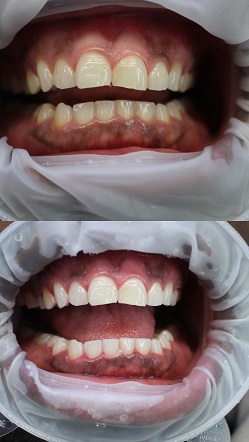Professional Teeth Whitening: What it takes to have that brighter smile.
Teeth whitening is an increasingly popular dental hygiene
technique that brightens teeth by removing stains and discolouration. This
procedure has quickly acquired popularity because of its capacity to improve
the aesthetic aspect of a person's smile, giving one a bright and confident
smile.
Tooth discolouration is a common oral health issue affecting millions
worldwide. In rare cases, changes in the colour of teeth from their regular
white look to more obvious discoloured tints such as yellow, brown, or even
black are referred to as the phenomenon.
Causes.
Teeth discolouration is caused by various sources, including extrinsic
(surface stains), intrinsic (inside the tooth), and age-related discolouration.
Understanding these characteristics is critical in preventing, managing, and
curing disease.
The most prevalent kind is extrinsic discolouration, caused by the
contact of the outer covering of teeth (enamel) with drinks, meals, or
cigarettes. Red wine, coffee, tea, cola beverages, and some fruits, such as
apples and potatoes, have powerful colour pigments that adhere to the tooth
enamel (Parmar and others, 2019). Furthermore, tobacco contains two compounds
(tar and nicotine) that generate tenacious yellow-brownish stains, whether
smoked or chewed.
In contrast, intrinsic discolouration occurs inside the tooth structure.
This variety may result from excessive fluoride exposure when teeth form in
early childhood. Other factors include tetracycline antibiotics given to
children under eight or pregnant women, which cause discolouration of the
child's growing teeth. Furthermore, uncommon genetic abnormalities such
as dentinogenesis imperfecta produce intrinsic
discolouration (Donly et al., 2019).
Trauma that causes internal bleeding or tooth injury can also result in
intrinsic discolouration. Discolouration secondary to pulp necrosis is one
example in which the tooth turns dark yellow, grey, or black due to the death
of the pulp tissue trapped within the tooth's complex layers.
The third cause is age-related discolouration, which is caused mainly by
ageing. The outer enamel layer peels away over time, exposing the naturally
yellow dental beneath. At the same time, the teeth may discolour for both
external and internal reasons throughout time.
Inadequate dental care, such as brushing and flossing, can also cause
discolouration by enabling plaque and stain-causing chemicals to accumulate on
the teeth.
Disease factors such as metabolic diseases, specific infections during
tooth development, or illnesses requiring head and neck radiation and
chemotherapy may impact tooth colouring. In other cases, the underlying cause
is iatrogenic since some dental materials used in restorative operations might
leave colouring residues on the teeth (Bhattacharya and colleagues, 2019).
A bright grin conveys a sense of confidence and personal cleanliness.
However, age, food, and hereditary factors can all contribute to dull,
yellowish teeth. The dental condition does not mean you must accept your fate;
in today's dental hygiene environment, several techniques and products may
efficiently whiten teeth.
Using Whitening Toothpaste and Mouthwash.
Incorporating whitening toothpaste and mouthwash into your regular oral
care routine is likely the most straightforward and least expensive approach to
begin whitening. These treatments use gentle abrasives and chemicals to remove
surface stains softly. To progressively whiten the teeth, experts recommend
regularly using the product as suggested on the package (ADA, 2018).
At Home Whitening
Due to their accessibility and convenience, at-home whitening treatments like gels and strips have experienced tremendous growth in popularity. These products work by being applied to the teeth for specific amounts. A coating of hydrogen peroxide or carbamide peroxide solution, a typical bleaching agent favoured by dental experts, is included in
whitening strips.
Professional Whitening Treatments.
Professional whitening procedures performed by a competent dentist are
advised for a more advanced and quick outcome. These sessions usually begin
with applying a high-concentration peroxide gel to the teeth and then using
unique lamps or lasers to speed up the whitening process. In only one session,
this approach can give many shades of whiter results (Li, Y. 2021).
Rather than employing cosmetic teeth whitening procedures, which can
occasionally cause gum irritation and enamel erosion, nature provides safe and
effective alternatives for achieving that angelic, white smile (Zaidel et al.,
2012).
Baking soda.
Baking soda is one of the most common natural teeth-whitening solutions.
Baking soda is a prominent component in many commercial forms of toothpaste
because of its inherent whitening properties. A recent study found that
toothpaste with baking soda effectively removes tooth stains and supports tooth
whitening ((Li et al., 2014).
Hydrogen peroxide.
Hydrogen peroxide is another effective natural treatment. When used
daily, this mild bleach efficiently whitens teeth. In lesser amounts, hydrogen
peroxide is present in most commercial whitening products. However, because
hydrogen peroxide can potentially induce gum inflammation or tooth sensitivity,
it should be used cautiously.
Oil pulling.
Another effective treatment is oil pulling, a traditional Indian practice encouraging good mouth cleanliness. Plaque and discolouration can be reduced by consuming a spoonful of coconut, sunflower, or sesame oil and swishing it in the mouth. Due to its tasty flavour and high lauric acid content, which is very helpful in lowering dangerous microorganisms, coconut oil is chosen for oil pulling (Thaweboon et al., 2011).
Apple cider vinegar.
Known for its purifying and disinfecting qualities, apple cider vinegar
can help whiten teeth (Johnston & Gaas, 2006). Apple cider vinegar, mainly
used for cleaning, successfully removes stains from teeth and whitens them.
Still, it should only be used seldom to prevent enamel deterioration.
Balanced food.
Additionally, eating a balanced diet of fruits and vegetables helps keep
teeth whiter. For instance, bromelain and malic acid, two naturally occurring
active enzymes recognized for their ability to whiten skin, are present in
strawberries and pineapples, respectively (Unlu et al., 2007).
While having a dazzling smile is nice, teeth whitening must be done
carefully. Every technique has limitations, and excessive usage may harm your
gums or cause your teeth to become sensitive. Before commencing teeth-whitening
tactics, speak with your dentist to ensure the technique is secure and
suitable. Once you have the correct information and advice, a whitened,
prettier, confident smile is guaranteed.
Photos: Dental Clinic Stedenwijk (http://tandartspraktijk-stedenwijk.nl)

